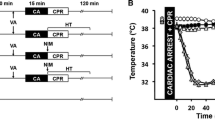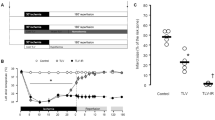Summary
The purpose of the present study was to evaluate the functional and biochemical effects of diltiazem (DTZ) on cardiac myocytes incubated under hypothermic conditions. Cardiac myocytes were isolated from neonatal rat ventricles and cultured for 4 days with MCDB 107 medium. Then, myocytes (12.5×105 myocytes/flask) were incubated at 4°C for 24 hours in media with or without DTZ at concentrations of 0 M (group C), 10−7 M (Group D1), 10−6 M (group D2), 10−5 M (group D3), or 10−4 M (group D4). After 24 hours at 4°C, CPK and LDH were measured. The myocytes were then cultured for 24 hours at 37°C to evaluate the recovery of the myocyte beating rate. In group C (n=7), the recovery ratio of the myocyte beating rate was 29.9% of control (beating rate prior to hypothermic incubation). Groups D1 and D2 (n=7 each) had approximately the same recovery ratios as group C (24.0% and 24.7%, respectively); however, groups D3 and D4 (n=7 each) showed no beating rate recovery. Release of CPK and LDH in group C was 112.3 mIU/flask and 457.4 mIU/flask, respectively. Groups D1 and D2 showed no significant differences in both enzymes compared to group C. However, the levels of CPK were significantly higher in group D4 (203.3, p<0.05), and LDH levels were significantly higher in groups D3 and D4 (669.3, p<0.05; 883.4, p<0.02). In conclusion, DTZ showed no protective effects on hypothermic injury to immature cardiac myocytes; moreover, it accelerated cellular injury at the concentrations of 10−5 and 10−4 M both functionally and biochemically. Therefore, diltiazem may not be suitable for cardiac preservation during the neonatal period.
Similar content being viewed by others
References
Wicomb W, Cooper DKC, Hassoulas J, et al. Orthotopic transplantation of the baboon heart after 20 to 24 hours' preservation by continuous hypothermic perfusion with an oxygenated hyperosmolar solution.J Thorac Cardiovasc Surg 1982;83:133–140.
Warner M, Guerraty A, Alivizatos P, et al. Assessment of myocardial subcellular function after 24 hours of in vitro preservation and transplantation.J Thorac Cardiovasc Surg 1982;83:290–297.
Burt JM, Copeland JG. Myocardial function after preservation for 24 hours.J Thorac Cardiovasc Surg 1986;92:238–246.
Takahashi A, Braimbridge MV, Hearse DJ, Chambers DJ. Long-term preservation of the mammalian myocardium. Effect of storage medium and temperature on the vulnerability to tissue injury.J Thorac Cardiovasc Surg 1991;102:235–234.
Jarmakani JM, Nakazawa M, Nagatomo T, Langer GA. Effect of hypoxia on mechanical function in the neonatal mammalian heart.Am J Physiol 1978;235:H469-H474.
Bove EL, Gallagher KP, Drake DH, et al. The effect of hypothermic ischemia on recovery of left ventricular function and preload reserve in the neonatal heart.J Thorac Cardiovasc Surg 1988;95:814–818.
Grice WN, Konishi T, Apstein CS. Resistance of neonatal myocardium to injury during normothermic and hypothermic ischemia arrest and reperfusion.Circulation 1987;76(Suppl V):V150-V155.
Melendez FJ, Gharagozloo F, Sun SC, et al. Effects of diltiazem cardioplegia on global function, segmental contractility, and the area of necrosis after acute coronary artery occlusion and surgical reperfusion.J Thorac Cardiovasc Surg 1988;95:613–617.
Barner HB, Jellinek M, Standeven JW, et al. Cold blood—diltiazem cardioplegia.Ann Thorac Surg 1982;33:55–63.
Standeven JW, Jellineck M, Menz LH, Kolata RJ, Barner HB. Cold blood potassium diltiazem cardioplegia.J Thorac Cardiovasc Surg 1984;87:201–212.
Christakis GT, Fremes SE, Weisel, et al. Diltiazem cardioplegia: A balance of risk and benefit.J Thorac Cardiovasc Surg 1986;91:647–666.
Klein I, Daood M. Regulation of the growth of nonmuscle heart cells in culture.In Vitro Cell Dev Biol 1985;21:693–696.
Suzuki T, Ohta M, Hoshi H. Serum-free, chemically defined medium to evaluate the direct effects of growth factors and inhibitors on proliferation and function of neonatal rat cardiac muscle cells in culture.In Vitro Cell Dev Biol 1989;25:601–606.
Blondel B, Roijen I, Cheneval JP. Heart cells in culture: A simple method for increasing the population of myoblasts.Experiential 1971;27:356–358.
Polinger IS. Separation of cell types in embryonic heart cell culture.Exp Cell Res 1970;63:78–82.
Yagev S, Heller M, Pinson A. Change in cytoplasmic and lysosomal enzyme activities in cultured rat heart cells: The relationship to cell differentiation and cell population in culture.In Vitro 1984;20:893–898.
Siegel S, Castellan NJ Jr. The Kruskal-Wallis one-way analysis of variance by ranks. In Anker JD, ed.Nonparametric Statistics for the Behavioral Sciences. New York: McGraw-Hill, 1988:206–216.
Siegel S, Castellan NJ Jr. The Wilcoxon-Mann-Whitney Test. In: Anker JD, ed.Nonparametric Statistics for the Behavioral Sciences. New York: McGraw-Hill, 1988:2128–2137.
Orita H, Fukasawa M, Hirooka S, et al. A cardiac myocyte culture system as an in vitro experimental model for the evaluation of hypothermic preservation.Surgery Today 1993;23:439–443.
Orita H, Fukasawa M, Hirooka S, et al. Protection of cardiac myocytes from hypothermic injury by cardiac fibroblasts isolated from neonatal rat ventricle.J Surg Res, 1993, in press.
Hendry PJ, Labow RS, Barry TA, Keon WJ. An assessment of crystalloid solutions for donor heart preservation.J Thorac Cardiovasc Surg 1991;101:833–838.
Fremes SE, Li RK, Weisel RD, et al. Prolonged hypothermic cardiac storage with University of Wisconsin solution. An assessment with human cell culture.J Thorac Cardiovasc Surg 1991;101:666–672.
Bush LR, Li YP, Shlafer M, Jolly SR, Luchesi BR. Protective effects of diltiazem during myocardial ischemia in isolated cat heart.J Pharmacol Exp Ther 1981;218:653–661.
Nayler WG. Calcium and cell death.Eur Heart J 1983;4(Suppl C):33–41.
Yamamoto F, Manning AS, Braimbridge MV, Hearse DJ. Calcium antagonist and myocardial protection: Diltiazem during cardioplegic arrest.Thorac Cardiovasc Surg 1988;31:369–373.
Chan WP, Bharadwaj B, Prasad K. Effects of diltiazem on the functional recovery of the myocardium at organ and cellular level during prolonged hypothermic ischemic cardiac arrest.Angiology 1990;43:702–714.
Murashita T, Hearse DJ, Avkiran M. Effects of diltiazem as an additive to St. Thomas's Hospital cardioplegic solution in isolated neonatal and adult rabbit hearts.Cardiovasc Res 1991;25:496–502.
Laarae AVD, Hollaar L, Kokshoorn LJM, Witteveen SAGJ. The activity of cardio-specific isoenzymes of creatine phosphokinase and lactate dehydrogenase in monolayer cultures of neonatal rat heart cells.J Mol Cell Cardiol 1979;11:501–510.
Acosta D, Puckett M, McMillin R. Ischemic myocardial injury in cultured heart cells: Leakage of cytoplasmic enzymes from injured cells.In Vitro 1978;14:728–732.
Boucek RJ, Shelton M, Artman M, et al. Comparative effects of verapamil, nifedipine and diltiazem on contractile function in the isolated immature and adult rat heart.Pediatr Res 1984;18:948–952.
Bers DM, Bridge JHB, Spizer KW. Intracellular Ca++ transients during rapid cooling contractures in guinea-pig ventricular myocytes.J Physiol 1989;417:537–553.
Hryshko LV, Stiffel V, Bers DM. Rapid cooling contractures as an index of sarcoplasmic reticulum calcium content in rabbit ventricular myocytes.Am J Physiol 1989;257:H1369–1377.
Nayler WG. The role of calcium in the ischemic myocardium.Am J Pathol 1981;102:262–270.
Janero DR, Burghardt B, Lopez R. Protection of cardiac membrane phospholipid against oxidative injury by calcium antagonist.Biochem Pharmacol 1988;37:4197–4203.
Brog TK. Development of the connective tissue network in the neonatal hamster heart.Anat Res 1982;165:435–444.
Weber KT, Brilla CG. Pathological hyptertrophy and cardiac interstitium.Circulation 1991;83:1849–1865.
Author information
Authors and Affiliations
Rights and permissions
About this article
Cite this article
Orita, H., Fukasawa, M., Hirooka, S. et al. In vitro evaluation of diltiazem on hypothermic injury to immature myocytes. Cardiovasc Drug Ther 7, 713–720 (1993). https://doi.org/10.1007/BF00877825
Received:
Accepted:
Issue Date:
DOI: https://doi.org/10.1007/BF00877825




